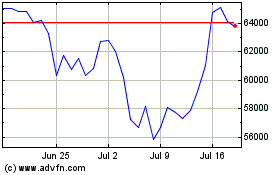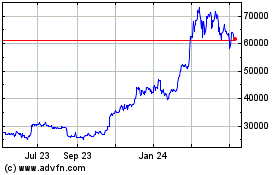87% Of Bitcoin Hodlers Laughing All The Way To The Bank – Here’s Why
June 20 2024 - 12:00PM
NEWSBTC
The current state of the Bitcoin market offers a mix of optimism
and caution for investors. Over 87% of Bitcoin holders are in
profit, with their investments valued higher than their initial
purchase prices. Related Reading: Whales Dump Over $1 Billion In
Bitcoin: Fire Sale Or Foreshadowing? On average, these investors
are seeing unrealized gains of 120%, a significant figure that
reflects the substantial rally that pushed Bitcoin to its all-time
high in March, according to Glassnode data. However, despite these
gains, the market exhibits both encouraging long-term trends and
some short-term uncertainties that merit closer examination.
Profitability And Market Metrics The profitability among Bitcoin
investors is notable. The MVRV (Market Value to Realized Value)
metric, a key indicator of market sentiment, remains comfortably
above its yearly baseline. This metric measures the ratio of
Bitcoin’s market value to its realized value and serves as a gauge
of average unrealized profit across the market. A high MVRV ratio
indicates that most investors are sitting on substantial unrealized
gains, painting a positive picture of the market’s health. This
upward trend contrasts with the recent price volatility,
underscoring the resilience of long-term investors who bought the
dip and are now seeing their foresight rewarded. Reduced Trading
Activity And Demand Despite the overall profitability, the Bitcoin
market is experiencing a notable reduction in trading activity. The
vibrant speculative trading that once characterized the market has
significantly diminished. Day traders, who previously capitalized
on price swings, have retreated, resulting in reduced trading
volumes and tepid demand. This lack of speculative trading has led
to a stagnation in Bitcoin prices, which are now confined to a
well-defined range. The market’s current state can be likened to a
calm period after a storm, where activity is subdued, and prices
sway gently without significant movement. Investor Caution And
Market Sentiment The reduced trading activity reflects a broader
sentiment of caution among investors. The current period of
consolidation suggests that many investors are taking a
wait-and-see approach, carefully assessing the market landscape
before making any decisive moves. This cautious sentiment is
further evidenced by on-chain data showing a significant decrease
in the flow of Bitcoin into exchanges. Typically, an increase in
Bitcoin transfers to exchanges is a precursor to selling activity,
as holders look to liquidate their positions. The current decline
in these transfers indicates that both short-term and long-term
holders are refraining from selling, preferring to hold onto their
assets. Related Reading: SEC Drama Fuels XRP Rally: Open Interest
Skyrockets Short-term holders, who once actively traded Bitcoin for
quick profits, are now transferring significantly fewer coins
compared to the peak levels seen in March. This behavior suggests a
shift towards a more conservative strategy, possibly in
anticipation of future price movements. Long-term investors, on the
other hand, appear content to maintain their positions, exhibiting
confidence in Bitcoin’s long-term potential despite the short-term
market stagnation. Featured image from Adobe Stock, chart from
TradingView
Bitcoin (COIN:BTCUSD)
Historical Stock Chart
From May 2024 to Jun 2024

Bitcoin (COIN:BTCUSD)
Historical Stock Chart
From Jun 2023 to Jun 2024
